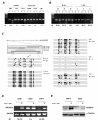The novel RASSF6 and RASSF10 candidate tumour suppressor genes are frequently epigenetically inactivated in childhood leukaemias
- PMID: 19570220
- PMCID: PMC2711046
- DOI: 10.1186/1476-4598-8-42
The novel RASSF6 and RASSF10 candidate tumour suppressor genes are frequently epigenetically inactivated in childhood leukaemias
Abstract
Background: The Ras-association family (RASSF) of tumour suppressor genes (TSGs) contains 10 members that encode proteins containing Ras-association (RA) domains. Several members of the RASSF family are frequently epigenetically inactivated in cancer, however, their role in leukaemia has remained largely uninvestigated. Also, RASSF10 is a predicted gene yet to be experimentally verified. Here we cloned, characterised and demonstrated expression of RASSF10 in normal human bone marrow. We also determined the methylation status of CpG islands associated with RASSF1-10 in a series of childhood acute lymphocytic leukaemias (ALL) and normal blood and bone marrow samples.
Results: COBRA and bisulphite sequencing revealed RASSF6 and RASSF10 were the only RASSF members with a high frequency of leukaemia-specific methylation. RASSF6 was methylated in 94% (48/51) B-ALL and 41% (12/29) T-ALL, whilst RASSF10 was methylated in 16% (8/51) B-ALL and 88% (23/26) T-ALL. RASSF6 and RASSF10 expression inversely correlated with methylation which was restored by treatment with 5-aza-2'deoxycytidine (5azaDC).
Conclusion: This study shows the hypermethylation profile of RASSF genes in leukaemias is distinct from that of solid tumours and represents the first report of inactivation of RASSF6 or RASSF10 in cancer. These data show epigenetic inactivation of the candidate TSGs RASSF6 and RASSF10 is an extremely frequent event in the pathogenesis of childhood leukaemia. This study also warrants further investigation of the newly identified RASSF member RASSF10 and its potential role in leukaemia.
Figures



References
Publication types
MeSH terms
Substances
Grants and funding
LinkOut - more resources
Full Text Sources
Molecular Biology Databases

